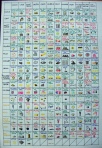For centuries, taxonomies have been a tool for mankind to bring structure to the world. Taxonomies (wikipedia: “the practice and science of classification”) were developed in different fields of science, including – but not limited to – biology (e.g. taxonomies of animals) or library sciences (e.g. taxonomies of literature). Regardless of the particular domain of application, in most cases those taxonomies were developed by a selected few (e.g. librarians), and were used by many.
With the emergence of personal computers and file directories, the task of taxonomy development was brought to the masses. Suddenly everyone (i.e. every computer user) was in charge of developing, maintaining and transforming personal taxonomical structures in order to organize and (re-)find resources. While this development has led to a vast increase of personal taxonomies, it was only since del.icio.us has popularized tagging as a new form of resource organization that users’ personal taxonomies were exposed publicly. This has made it possible to aggregate a large number of personal taxonomies into collective taxonomic structures. The result of such aggregation has since then been refered to as folksonomies, i.e. an emergent structure collectively produced by a large number of users in a bottom-up manner.
In social awareness streams (pdf) such as Twitter of Facebook, users typically do not aim to classify or organize resources, but they engage in casual chatter and dialogue, ocassionally using syntax to coordinate communication (such as #hashtags or @replies). Taxonomic structures can be assumed to play a subordinate role for users of social awareness streams.
In a recent paper to be presented at the SemSearch Workshop at WWW2010 [1] however, we show that there exist latent conceptual structures – similar to taxonomies or folksonomies – in social awareness streams, and that we can acquire these structures through simple aggregation mechanisms.
Abstract: Although one might argue that little wisdom can be conveyed in messages of 140 characters or less, this paper sets out to explore whether the aggregation of messages in social awareness streams, such as Twitter, conveys meaningful information about a given domain. As a research community, we know little about the structural and semantic properties of such streams, and how they can be analyzed, characterized and used. This paper introduces a network-theoretic model of social awareness streams, a so-called “tweetonomy”, together with a set of stream-based measures that allow researchers to systematically de fine and compare di fferent stream aggregations. We apply the model and measures to a dataset acquired from Twitter to study emerging semantics in selected streams. The network-theoretic model and the corresponding measures introduced in this paper are relevant for researchers interested in information retrieval and ontology learning from social awareness streams. Our empirical findings demonstrate that di fferent social awareness stream aggregations exhibit interesting di fferences, making them amenable for di fferent applications [1].
In the paper, we introduce the notion of tweetonomies, and a corresponding tri-partite model of social awareness streams that extends the existing model of folksonomies by accomodating user-generated syntax (such as slashtags and other emerging syntax) and thereby integrating the communicative nature of such streams.
In the figure below, we have applied the network-theoretic model of tweetonomies to acquire a semantic network of hashtags that could be used for a range of different purposes, such as for navigating social awareness streams or for recommendation problems.

A tweetonomy of hashtags, aquired from Twitter (with the help of Jan Poeschko, click for full image 2.6 MB)
Our work shows that tweetonomies are a far more complex structure than – for example – taxonomies or folksonomies. One reason for that observation lies in the dynamic and user-generated nature of its syntax, but also in the fact that tweetonomies accomodate a much richer language than the language used in social tagging systems (tweets vs tags).
The results of our work suggest that tweetonomies are a novel and promising concept, different from taxonomies and folksonomies where people engage in conscious acts of classification. Whether tweetonomies have the potential to bring order and structure to social awareness streams similar to the way folksonomies brought order to social tagging systems remains a question to be answered.
Update (May 5 2010): An interesting question that was raised during the presentation of the paper at the WWW’2010 workshop was whether it would be justified to introduce Tweetonomies as a new concept. In other words, are the structures that we observe on twitter not just a different form of folksonomies? I’d argue for the necessity of a new concept for the following reasons: While taxonomies and folksonomies emerge when users structure resources, tweetonomies emerge when users structure conversation. Because conversations are inherently different than resources (e.g. they are dynamic, and involve multiple users) the structures that emerge from social awareness streams (tweetonomies) can be expected to be different from the structures that emerge from social bookmarking systems (folksonomies). Whether this is really the case however needs to be investigated in future work.
References:
[1] C. Wagner, M. Strohmaier, The Wisdom in Tweetonomies: Acquiring Latent Conceptual Structures from Social Awareness Streams, Semantic Search 2010 Workshop (SemSearch2010), in conjunction with the 19th International World Wide Web Conference (WWW2010), Raleigh, NC, USA, April 26-30, ACM, 2010. (pdf)

